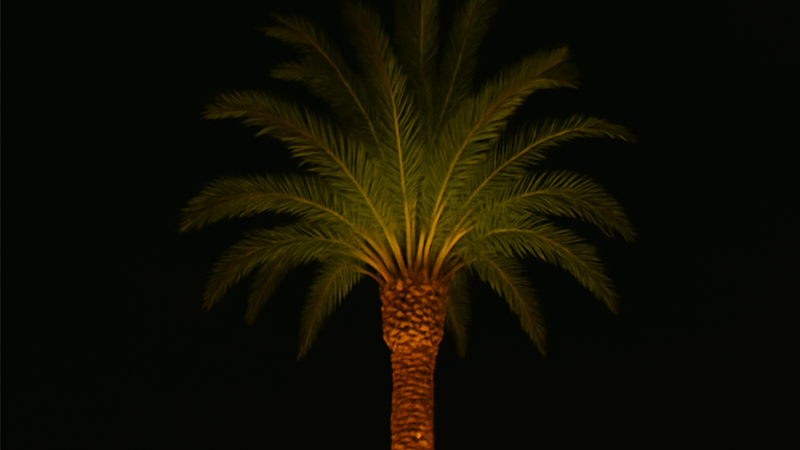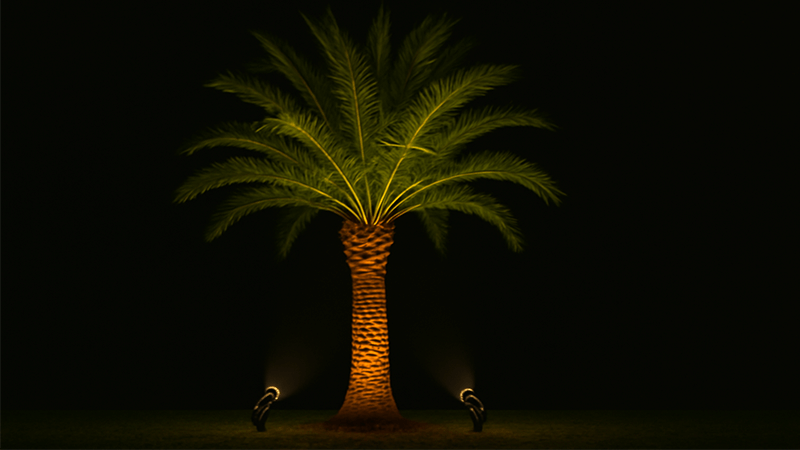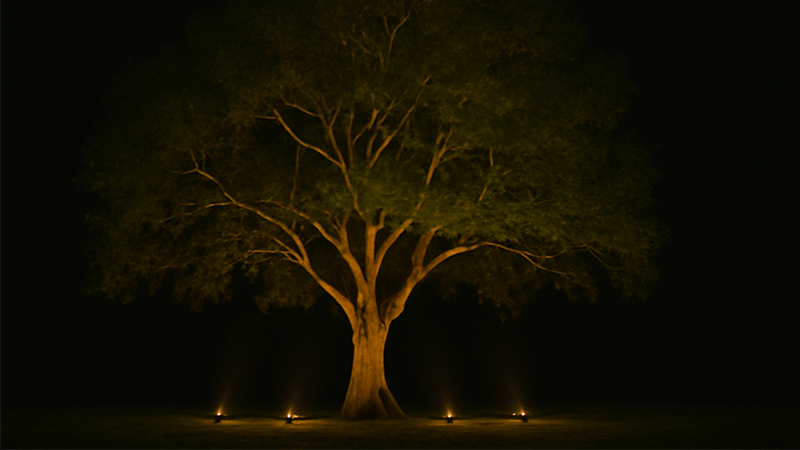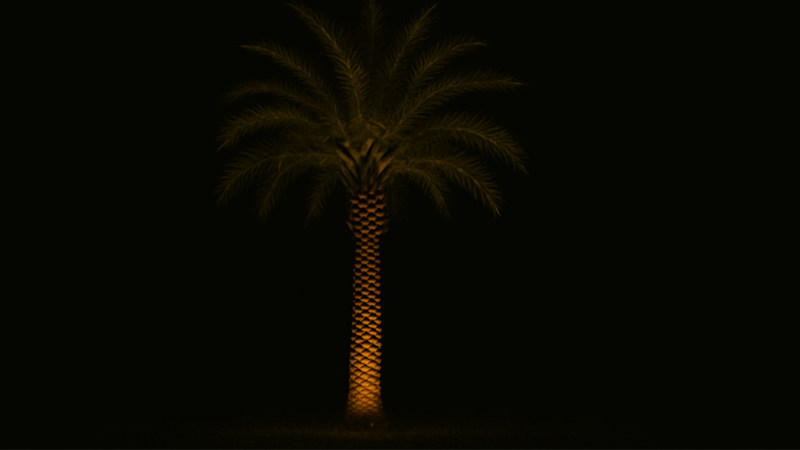Struggling to make your palm trees stand out at night? You light them up, but they look flat and washed out, failing to capture their tropical elegance.
The ideal lumen count for lighting a palm tree ranges from 1,000 to 5,000 lumens, depending on its size. For smaller palms under 15 feet, 1,000-1,500 lumens is often enough. For taller palms, using multiple fixtures to achieve 2,000-5,000 lumens creates a more dramatic effect.

Getting the lumen count right is just the start. I’ve been in the LED lighting business for a long time, starting on the factory floor and building my company, Upward Lighting, from the ground up. I’ve learned that the most stunning landscape lighting isn’t about sheer brightness. It’s about precision and artistry. A precise beam of light carving a shape out of the darkness is far more dramatic and beautiful than a uniform floodlight. The success of lighting a palm tree isn’t about making the tree bright, but about creating a clear, beautiful silhouette against the night sky. To do that, we need to look beyond just the lumens.
How much light for a palm tree?
You know a palm tree needs light, but you’re guessing how much. This gamble can lead to overpowering brightness that creates light pollution or a weak glow that gets lost.
For most residential and commercial palm trees, 1 to 3 spotlights are ideal. A smaller palm (under 15 ft) needs one 800-1200 lumen fixture. A larger palm (15-40 ft) looks best with two or three fixtures totaling 2000-5000 lumens, highlighting both the trunk and fronds.

When we talk about "how much light," we’re really asking about creating a specific effect. Simply flooding a palm tree with light is a common mistake. It erases the very details you want to feature: the rough texture of the trunk and the delicate shape of the fronds. The goal is to use light to sculpt the tree out of the darkness. I remember working with a client in the UAE, a purchasing manager named Shaz, who was responsible for lighting a row of large date palms at a luxury resort. His initial plan was to use powerful floodlights. I suggested a different approach. Instead of one big light source, we used multiple, lower-lumen spotlights with specific beam angles.
Choosing the Right Beam Angle
The beam angle determines how wide or narrow the cone of light is. For palm trees, this is critical. A narrow beam (10-15 degrees) is perfect for "grazing" the trunk. This technique shoots a tight beam of light up the trunk, creating dramatic shadows in the bark’s texture. It emphasizes height and form. For the fronds, a wider beam (30-45 degrees) works better. It gently illuminates the canopy from below, revealing its shape without looking harsh.
Selecting the Perfect Color Temperature (CCT)
Color temperature, measured in Kelvin (K), sets the mood. For palm trees, a warm white light (2700K – 3000K) is almost always the best choice. This CCT range enhances the natural brown and green tones of the tree, creating a welcoming and relaxing atmosphere. A cooler, bluer light (4000K and above) can make the tree look sterile and unnatural, which is not what you want for a landscape feature.
Strategic Fixture Placement
Where you place the fixtures is as important as the fixtures themselves. For a single palm, placing one or two fixtures a few feet from the base and aiming them up is a good start. For a truly professional look, use three fixtures in a triangle formation around the base. Two can have narrow beams to graze the trunk, while the third uses a wider beam for the canopy. This layering of light creates depth, dimension, and a truly captivating final look.
| Feature |
Narrow Beam (10-25°) |
Wide Beam (30-60°) |
| Primary Use |
Highlighting tall, narrow trunks; architectural details. |
Illuminating the wide canopy of fronds. |
| Effect |
Creates strong shadows, emphasizing texture and height. |
Provides a soft, even wash of light over a large area. |
| Placement |
Close to the base of the trunk. |
Further back from the base, aimed at the fronds. |
For Shaz’s project, we used this exact strategy. The result was stunning. The light didn’t just illuminate the palms; it revealed their character.
How many lumens to light up a tree?
You need a simple rule for lighting trees, but they come in all shapes and sizes. Applying one fixed lumen value to every tree will only lead to inconsistent and disappointing results.
As a general starting point, use about 50 lumens for every foot of tree height for narrow trees and 100 lumens per foot for wide canopies. For a 40-foot-tall palm tree, you would start with around 2,000 lumens (40 ft x 50 lumens) and adjust from there.

This "lumens per foot" rule is a great starting point, but it’s not the final answer. It gives you a number to begin with, but the art of tree lighting is in the adjustment. The type of tree, the density of its leaves, the color of its bark, and the ambient light in the area all play a huge role. I’ve learned that you can’t have a one-size-fits-all solution. You have to adapt your approach to the specific tree you’re working with. A delicate Japanese maple with sparse leaves needs a much gentler touch than a dense, mighty oak tree. The goal is always the same: to reveal the tree’s natural beauty, not to overwhelm it with light.
Lighting Different Tree Types
Every tree has a unique personality. Your lighting should reflect that. A tall, slender evergreen needs a different approach than a short, wide-canopied flowering tree. For evergreens like pines or firs, narrow-beam uplights can emphasize their conical shape and height. For deciduous trees with interesting branch structures, like oaks or maples, using multiple lights can highlight the intricate network of branches, especially in winter when the leaves are gone. The key is to look at the tree and decide what feature you want to be the star.
The Art of Layering Light
Instead of using one powerful floodlight, think like a painter using layers of color. Use multiple, lower-wattage fixtures to create depth and interest. A common technique is to use two lights on the trunk to create a cross-lighting effect, which eliminates harsh shadows and shows off the trunk’s full, round shape. Then, add another fixture or two placed further back to catch the underside of the canopy. This layering separates the trunk from the canopy, giving the tree a three-dimensional feel at night. It’s not just about making the tree visible; it’s about giving it form and presence.
Considering the Background
What is behind the tree? If the tree is against a dark, empty sky, you need less light to make it pop. The contrast will do most of the work. My core philosophy is that the shape a tree cuts in the darkness is more important than how bright it is. If the tree is in front of a wall or another building, you have to be more careful. You might need more light to make the tree stand out from the illuminated background. You also want to avoid creating ugly shadows on the wall behind it. In this case, aiming the lights more directly upward, rather than backward, is a better strategy.
| Tree Type |
Typical Height |
Suggested Lumen Range |
Lighting Technique |
| Small Ornamental |
5 – 15 ft |
300 – 800 lumens |
One or two small spotlights with a soft, wide beam. |
| Palm Tree |
15 – 50 ft |
1000 – 5000 lumens |
Narrow beams on the trunk, wider beams on fronds. |
| Medium Shade Tree |
20 – 40 ft |
1500 – 3000 lumens |
Multiple fixtures to layer light on trunk and canopy. |
| Large Evergreen |
40 – 80+ ft |
2500 – 8000+ lumens |
Powerful, narrow-beam spotlights aimed high. |
Do palms need bright light?
You see powerful lights aimed at palms and assume they need intense brightness. This often leads to a harsh, unnatural glare that washes out the tree’s texture and silhouette.
No, palms do not need overly bright light. They benefit most from strategic, well-placed lighting that emphasizes their shape. Using multiple lower-lumen fixtures to create contrast and shadow is far more effective than one powerful, high-lumen floodlight. The goal is elegance, not just brightness.

In my years of manufacturing and designing lighting solutions, I have seen many projects where the biggest mistake was using too much light. When you’re lighting a living thing like a palm tree, the goal is to enhance its natural beauty, not to blast it with artificial light. Brightness can easily become glare. Glare is the enemy of good landscape lighting. It’s uncomfortable for the viewer and it makes the subject look flat. A palm tree has incredible texture in its trunk and a unique silhouette in its fronds. Bright, direct light erases all of that. Soft, strategically aimed light reveals it.
The Problem with "Hot Spots"
When you use a single, very bright light source, you create a "hot spot." This is an intensely bright area on the tree that draws all the attention. The rest of the tree falls into deep shadow, and the overall effect is unbalanced and amateurish. The human eye is naturally drawn to the brightest point, so the viewer misses the beauty of the entire tree. I always advise my partners, people like Shaz who are sourcing lights for big projects, to think about the entire scene. We want the eye to travel up the trunk and across the canopy, not just get stuck on one glaring spot.
Focusing on Contrast, Not Just Illumination
Great lighting is all about contrast—the interplay of light and shadow. Instead of trying to eliminate all shadows, you should use them to your advantage. A narrow beam of light grazing up a palm trunk creates deep shadows in the bark, making it look more rugged and textured. Gently lighting the underside of the fronds allows their individual shapes to stand out against the dark sky. You are essentially using darkness as a canvas and light as your brush. This approach requires less total lumens but far more skill and thought.
Impact on Ambiance and Environment
Overly bright lighting doesn’t just look bad; it can ruin the ambiance of an entire outdoor space. It contributes to light pollution, which can disrupt wildlife and waste energy. A well-designed lighting scheme uses only as much light as is necessary. It creates a beautiful effect while respecting the nighttime environment. For a resort or a private residence, the goal is to create a peaceful, elegant atmosphere. Harsh, bright lights do the opposite. They feel more like a parking lot than a paradise. Using warmer color temperatures (like 3000K) and focusing on targeted, low-lumen lighting is the key to achieving that high-end feel.
Is 3000 lumens enough to grow plants?
You’re thinking about lighting and wondering if it can also help your plants grow. This mixes up the purpose of landscape lighting with the specific needs of horticultural lighting.
No, 3000 lumens of standard landscape lighting is not sufficient or suitable for growing plants. Plant growth requires a specific spectrum of light (especially red and blue wavelengths), not just brightness (lumens). Landscape lights are designed for visual appeal, not photosynthesis.

This is a question I hear from time to time, and it comes from a good place. If you’re putting light on a plant, shouldn’t it help it grow? But it’s important to understand the difference between lighting for humans and lighting for plants. As a manufacturer, we build lights for very different purposes. My company, Upward Lighting, specializes in outdoor architectural and landscape lighting. The LEDs, drivers, and optics are all designed to make things look good to the human eye at night. Lights designed for growing plants, called horticultural lights, are a completely different science.
Lumens vs. PAR: The Right Way to Measure Light for Plants
Lumens measure how bright a light appears to the human eye. Our eyes are most sensitive to yellow and green light. Plants, however, don’t care much about lumens. They need light for photosynthesis, and the key metric for that is Photosynthetically Active Radiation (PAR). PAR measures the specific wavelengths of light that plants use to grow—primarily in the blue and red parts of the spectrum. This is why many professional grow lights have a purplish or pinkish glow. They are concentrating their energy on producing the light plants need, not the light humans see well. A 3000-lumen landscape light might have very low PAR value, making it useless for plant growth.
The Spectrum is Everything
Standard white LED landscape lights produce a broad spectrum of light to achieve a good Color Rendering Index (CRI), so that colors look natural to us. But much of that light energy is in the green and yellow parts of the spectrum, which plants mostly reflect away. It’s wasted energy from a plant’s perspective. Horticultural lights are engineered to deliver precise wavelengths.
- Blue Light (400-500 nm): Encourages vegetative growth (leaves and stems).
- Red Light (600-700 nm): Promotes flowering and fruiting.
A standard 3000K warm white spotlight simply doesn’t have enough concentrated energy in these specific bands to fuel robust growth.
Heat and Duration
Landscape spotlights, especially higher-lumen ones, can produce a significant amount of heat at the fixture. While our LED fixtures at Upward Lighting are designed to dissipate heat efficiently away from the electronics, placing one very close to a plant’s leaves could still cause burning or drying. Furthermore, plants need a consistent light/dark cycle. They photosynthesize during the day (light) and respire at night (dark). Leaving a landscape light on a plant all night can disrupt this natural cycle, causing stress to the plant. Landscape lighting is typically on for a few hours in the evening for aesthetic purposes, which is not the long, consistent duration required for supplemental growth lighting.
| Lighting Type |
Primary Metric |
Spectrum Focus |
Primary Purpose |
| Landscape Lighting |
Lumens / CRI |
Broad (White Light for human vision) |
Aesthetics, safety, and security for human observers. |
| Horticultural Light |
PAR / PPFD |
Narrow (Concentrated Blue and Red wavelengths) |
Photosynthesis and plant growth regulation. |
Conclusion
To light a palm tree effectively, focus on precision over power. Use 1000-5000 lumens strategically, sculpting the tree’s form with narrow beams on the trunk and wider beams on the fronds.